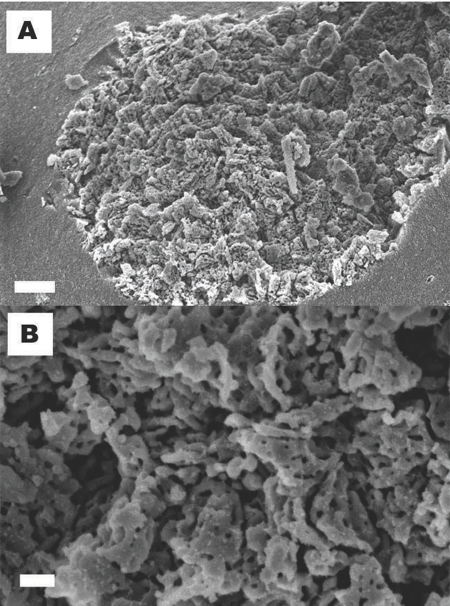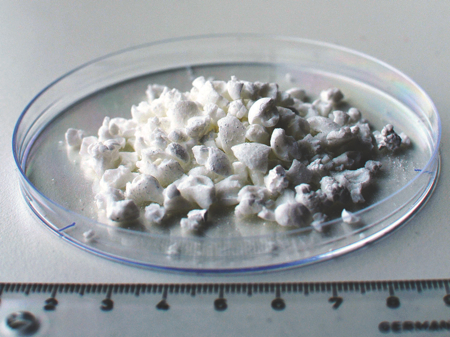It was supposed to be impossible, but researchers from Sweden have succeeded in manufacturing an anhydrous form of magnesium carbonate at synthesis temperatures well below 100°C. Not only that, but the material turned out to be micro-porous and amorphous (non-crystalline) and its properties are said to be game changing – over 800m2/g in surface area, better water adsorption ability than any other similar material and all at a very low manufacturing cost. The researchers who are currently testing this fascinating material foresee numerous new applications – one of which is to enhance the solubility of drugs. Having carried out some initial tests with poorly soluble drugs they have already found three products for which they can improve the solubility.
The magnesium carbonate material – which has been given the name Upsalite – also has the potential to control environmental moisture with a relatively low energy cost, and therefore has potential applications in humidity control, sometimes necessary for the production of pharmaceuticals and key to sectors such as electronics. It can also be used for the collection of toxic waste, chemicals or oil spills and for odour control and sanitation following fires.
Johan Goméz de la Torre, researcher at the Nanotechnology and Functional Materials Division, explained why its synthesis is so remarkable. ‘In contrast to what has been claimed for more than 100 years in the scientific literature, we have found that anhydrous and amorphous magnesium carbonate can be made in a very simple, low-temperature process’.
Most materials in nature are crystalline, since this is the thermodynamically most stable state; however, amorphous materials can be obtained through different fabrication routes – for example, glass is fabricated by rapid cooling of the glass melt that hinders the atoms from arranging in a crystalline lattice. While ordered crystalline forms of magnesium carbonate, both with and without water in the structure, are abundant in nature, water-free disordered forms have proved extremely difficult to make. Water-free in this context means no water molecules in the actual structural make up of the material, i.e. inside the material.
Upsalite is prone to adsorb water molecules onto its surface but this water does not act like a constituent of the material itself
Maria Strømme, Professor of Nanotechnology and head of the Nanotechnology and Functional Materials Division, adds: ‘Many forms of magnesium carbonates exist in nature but the most common ones all contain water molecules in their structure (so called hydrated forms such as nesquehonite (MgCO3·3H2O) and hydromagnesite (4MgCO3·Mg(OH)2·4H2O). Like the crystalline magnesite (MgCO3), the amorphous Upsalite is anhydrous and does not contain any water in its atomic structure.’ Upsalite is, however, prone to adsorb water molecules onto its surface but this water does not act like a constituent of the material itself.
In 1908, German researchers claimed that no magnesium carbonate could be made in the same way as other alkaline earth metal carbonates, by bubbling CO2 through an alcoholic suspension containing the corresponding metal oxide. Subsequent studies in 1926 and 1961 came to the same conclusion – and it was quite by chance that the discovery was made, says Goméz de la Torre. ‘A Thursday afternoon in 2011, we slightly changed the synthesis parameters of the earlier employed unsuccessful attempts, and by mistake left the material in the reaction chamber over the weekend. Back at work on Monday morning we discovered that a rigid gel had formed and after drying this gel we started to get excited.’
After having gone through a number of state-of-the-art materials characterisation techniques it became clear that we had indeed synthesised the material that previously had been claimed impossible to make
A year of detailed materials analysis and fine tuning of the experiment followed. One researcher used his Russian language skills to look up some of the chemistry details necessary for understanding the reaction mechanism, which were only available in an old Russian PhD thesis. ‘After having gone through a number of state-of-the-art materials characterisation techniques it became clear that we had indeed synthesised the material that previously had been claimed impossible to make,’ says Strømme.
The most interesting discovery, however, was not that they had produced a new material but the striking properties that this novel material possessed. It turned out that Upsalite had the highest surface area measured for an alkali earth metal carbonate – 800m2/g. ‘This places the new material in the exclusive class of porous, high surface area materials including mesoporous silica, zeolites, metal organic frameworks, and carbon nanotubes,’ says Strømme.

Figure 1 Electron microscopy images of Upsalite. a) SEM micrograph. Scale bar, 1µm; b) Higher magnification SEM clearly showing the textural porosity of the material. Scale bar, 200nm
‘In addition we found that the material was filled with empty pores all having a diameter smaller than 10nm. This pore structure gives the material a unique way of interacting with the environment, leading to a number of properties important for application of the material.’
This very large absorption surface area for a carbonate with many reaction sites per gram makes it interesting to drug developers. The bioavailability of crystalline pharmaceutical substances is often limited by their poor aqueous solubility but this can be improved by formulating the active substance in the amorphous state that offers a higher solubility. Strømme explains: ‘Poorly soluble drugs are not able to crystallise in the pores because of the small size and structure of the pores.’
Although the possibility of stabilising amorphous drugs inside nano-sized pores of carbon nanotubes and ordered mesoporous silica has been demonstrated, no conventional pharmaceutical excipients have so far been shown to possess this property. Magnesium carbonate – an already known excipient with no toxicity – made an obvious choice of material to investigate says Strømme.
The aim was to see if we could produce an even better excipient material made of magnesium carbonate
‘We have been working with different forms of nanoporous calcium carbonates intended for use in drug formulations previously and the aim was to see if we could produce an even better excipient material made of magnesium carbonate.’
Because Upsalite has the same chemical composition as the known excipient and its particle size is no different, Strømme believes regulatory acceptance should be quite smooth. ‘Its non-toxicity, its ability to adsorb moisture, its large surface area and controlled pore size in the lower nanometre range allow it to be used as a stabiliser of amorphous active pharmaceutical ingredients (APIs).
Additionally, the material can adsorb moisture in a drug formulation to protect sensitive APIs from hydrolysis. The novel substance has an adsorption capacity ~50% larger than that of the hygroscopic zeolite-Y at low relative humidities and with the ability to retain more than 75% of the adsorbed water when the humidity is decreased from 95% to 5% at room temperature. These properties can be regenerated by heat treatment at temperatures <100°C, making it a relatively low-cost process.

Figure 2 The adsoption properties can be regenerated by heat treatment at temperatures below 100°C
The discovery is to be commercialised though the University spin-out company Disruptive Materials, formed by the researchers together with the holding company of Uppsala University. Strømme says: ‘Since we are currently only able to produce lab-scale quantities of the material, we are now trying to find external partners to help us scale up the production of Upsalite. We are also in close contact with several industrial companies who would like to test the material in their respective applications.
She says more than 500 companies and institutes have contacted them to make enquiries about samples for tests since the recent announcement of the discovery. During the next few months the company wants to start evaluation projects with various industrial partners in different application areas and thereafter decide how to move forward with respect to manufacturing and sales.
Stabilising amorphous state APIs
A previous study by the researchers at Uppsala University2 has demonstrated the potential of using CaCO3, a widely used excipient in oral drug formulations, to stabilise the amorphous state of active pharmaceutical ingredients, in particular celecoxib. After incorporation of celecoxib in the vaterite particles, a five- to six-fold enhancement in apparent solubility of celecoxib is achieved due to pore-induced amorphisation.
To eliminate the possibility of uncontrolled phase transitions, the vaterite particles were stored in an inert atmosphere at 5°C throughout the study. Also, to demonstrate that the amorphisation effect was indeed associated with vaterite mesopores, accelerated stress conditions of 100% relative humidity were employed to impose transition from mesoporous vaterite to an essentially non-porous aragonite phase of CaCO3, which shows only limited amorphisation ability.
An improvement in solubility was also confirmed for ketoconazole when formulated with the mesoporous vaterite. Synthesis of the carrier particles and the incorporation of the active substances were carried out simultaneously in a one-step procedure, enabling easy fabrication.
References
1. Johan Forsgren, et al. A Template-Free, Ultra-Adsorbing, High Surface Area Carbonate Nanostructure. PLoS ONE 2013 8(7): e68486; doi:10.1371/journal.pone.0068486
2. Johan Forsgren, et al. Mesoporous Calcium Carbonate as a Phase Stabilizer of Amorphous Celecoxib – An Approach to Increase the Bioavailability of Poorly Soluble Pharmaceutical Substances. First published online: 23 May 2013 DOI: 10.1002/adhm.201200391 http://onlinelibrary.wiley.com/doi/10.1002/adhm.201200391/abstract




